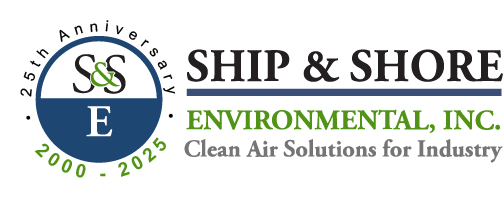RTO for Expanded Polystyrene Manufacturer
Expanded Polystyrene (EPS) has become indispensable in our daily lives for its light weight, insulative, and protective properties. It’s a material (foam product) most commonly utilized in protective packaging but is finding more applications in engineering and construction applications overthrowing the conventional, time-consuming heavy materials and methods. Uses include architectural elements, automotive panels / lost foam parts, geofoam, flotation, and safety devices among others.
Unfortunately, VOC (solvent) emissions from the EPS manufacturing process contribute to poor air quality (ozone) that could impact our health. For this reason, regulatory authorities have targeted emissions from the industry for treatment and EPS members have embraced treatment regulations to position EPS materials as a sustainable material choice for years to come.
As a leading technology provider, Ship & Shore has left a vast imprint in the industry thru innovative solutions. Ship & Shore designs and fabricates highly efficient abatement systems that reduce capital and operating expense – Metrics well received by process engineers and their management teams. As VOC regulatory conditions and corporate budgets tighten, low cost, durable, and flexible solutions are needed to reduce operational footprints, such as Thermal Oxidizer for EPS Manufacturer solutions.
EPS operations require customized abatement systems to handle potential high VOC concentrations. Depending on environmental regulatory jurisdiction, process emissions from a variety of sources could be targeted to meet environmental permit requirements. These could include:
- Bead Storage Areas
- Bead Dump to Hopper
- Pre-Expander Operation
- Fluidized Bed Dryers
- Block / Shape Mold Releases
- Vacuum System Exhaust
- Pre-puffed Silo Storage Areas
- Finished Product Ambient or Heated Aging Rooms
- RTO for EPS Foam Manufacturer
Each of the above sources have a unique emission profile that influences abatement equipment design for best control. Abatement systems are custom engineered to fit a customer’s regulatory requirements based on their mold or shape process, production, hours of operation, and quantity of VOCs (pentane content) they are emitting. Total process exhaust air volume, particulate, and moisture content all have an impact in the materials of construction, sizing, and operation of a Regenerative Thermal Oxidizer (RTO) technology which has proven to be the preferred abatement technology.

Typical RTO system design is for 98% VOC destruction efficiency at an operating temperature of 1500°F. The RTO consists of two insulated heat recovery media chambers and combustion chamber where the EPS process exhaust pass. The beds have a 95% thermal effectiveness to capture the heat from the contained combustion process. Natural gas usage to operate the RTO is minimal, and in many cases, the RTO will self-sustain. Meaning the RTO will operate on the pentane BTU value only and will not require any natural gas consumption to operate. Ship and Shore technology is performance proven, reliable, and maintenance friendly.
The Ship & Shore RTO system is comprised of the following main components:
- Process ductwork collection system.
- Pre-filtration to capture bead material entrained in process exhaust.
- An inlet fan to deliver pentane laden air stream for treatment.
- Two ceramic filled vertical heat exchange towers for preheating and energy recovery.
- A combustion chamber in between the two ceramic heat exchange towers where pollutants are destroyed.
- Poppet valve technology to direct the air flow alternatively to both the media chambers providing maximum operational
- Exhaust stack for final dispersion to atmosphere.
In addition, heat from the clean air exhaust can be captured by secondary heat exchangers to provide recovered energy for heated bag or block drying rooms. This helps to establish consistent product environment for reliable product quality. Energy from the RTO exhaust is also used for winter comfort heating in the factory building or hot water. All sustainable techniques to help manufacturers save significantly in operating costs.
Key to a successful project is the design of the collection system. We utilize unique process strategies to cascade and recirculate process air within a facility to maximize VOC collection efficiency for destruction. These techniques reduce RTO equipment sizing and enhance BTU value in the exhaust stream for lowest cost operation.
Abatement designs can also incorporate boiler oxidizing systems depending on permit requirements and volume required. However, tightening regulatory requirements have called for more and more sources to be controlled, dictating a larger volume abatement capability (hence RTO technology).
For 20 years we have demonstrated innovative VOC control system designs across many industrial applications. We have complete fabrication, installation, and service capabilities. And with early project involvement, our technical staff can provide regulatory guidance essential to cement understanding of local abatement control needs.
Finally, RTO systems and secondary heat recovery can qualify for REBATE INCENTIVE payouts from local natural gas and electric utility providers. Ship & Shore has secured millions of dollars in incentives over the years (generally six figure payouts) for our customers due to our skilled energy analysis capabilities.
New or upcoming expansion projects generally trigger new or expanded abatement needs. As a valued supplier to the industry, we develop technical solutions that meet the most stringent VOC regulatory requirements that are SAFE!!! Safety will always guide design and will remain Ship & Shore’s number one focus. We strive for the best available technology and by doing so, will always keep safety, schedule, capital cost, ease of maintenance, equipment longevity, and operating cost, in mind before we make a project recommendation.

